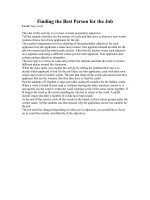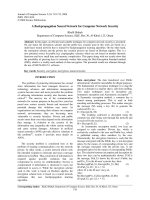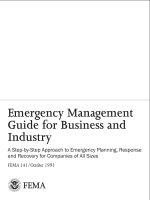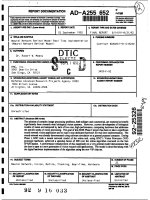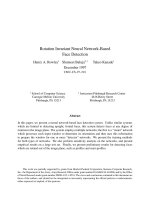Finding minimal Neural Network for Business
Bạn đang xem bản rút gọn của tài liệu. Xem và tải ngay bản đầy đủ của tài liệu tại đây (742.38 KB, 50 trang )
Finding Minimal Neural Networks for
Business Intelligence Applications
Rud
y
Setiono
y
School of Computing
National University of Singapore
d/d
www.comp.nus.e
d
u.sg
/
~ru
d
ys
Outline
• Introduction
• Feed-forward neural networks
•
Neural
network
training
and
pruning
•
Neural
network
training
and
pruning
• Rule extraction
• Business intelligence applications
• Conclusion
•
References
References
• For discussion: Time-series data mining
2
using neural network rule extraction
Introduction
• BusinessIntelligence(BI):Asetofmathematicalmodelsandanalysis
methodologiesthatexploitavailabledatatogenerateinformationand
knowledgeusefulforcomplexdecision‐makingprocess.
•
Mathematical models and analysis methodologies for BI include various
•
Mathematical
models
and
analysis
methodologies
for
BI
include
various
inductivelearningmodelsfordataminingsuchasdecisiontrees,artificial
neuralnetworks,fuzzylogic,geneticalgorithms,supportvectormachines,
andintelligentagents.
3
Introduction
BI Analytical Applications include:
• Customersegmentation:Whatmarketsegmentsdomycustomersfallinto,
andwhataretheircharacteristics?
• Propensitytobuy:Whatcustomersaremostlikelytorespondtomy
promotion?
• Frauddetection:HowcanItellwhichtransactionsarelikelytobefraudulent?
Ct tt iti
Whi h t i t ik f li?
•
C
us
t
omera
tt
r
iti
on:
Whi
c
h
cus
t
omer
i
sa
t
r
i
s
k
o
f
l
eav
i
ng
?
• Creditscoring:Whichcustomerwillsuccessfullyrepayhisloan,willnot
defaultonhiscreditcardpayment?
•
Time
series prediction
4
•
Time
‐
series
prediction
.
Feed-forward neural networks
A feed-forward neural network with one hidden layer:
ibl l i
• Inputvar
i
a
bl
eva
l
uesareg
i
ven
totheinputunits.
• Thehiddenunitscom
p
utethe
p
activationvaluesusinginput
valuesandconnectionweight
valuesW.
• Thehiddenunitactivationsare
giventotheoutputunits.
• Decisionismadeattheoutput
layeraccordingtotheactivation
valuesoftheoutputunits.
5
Feed-forward neural networks
Hiddenunitactivation:
•
Compute the weighted input: w
1
x
1
+ w
2
x
2
+ …. + w
x
Compute
the
weighted
input:
w
1
x
1
+
w
2
x
2
+
….
+
w
n
x
n
• Applyanactivationfunctiontothisweightedinput,forexamplethelogistic
fif( ) 1/(1
)
f
unct
i
on
f(
x
)
=
1/(1
+e
‐x
)
:
6
Neural network training and pruning
Neuralnetworktraining:
• Findanoptimalweight(W,V).
• Minimizeafunctionthatmeasureshowwellthenetworkpredictsthedesired
outputs (class label)
outputs
(class
label)
• Errorinpredictionfori‐th sample:
e
= (desired output)
–
(predicted output)
e
i
=
(desire d
output)
i
–
(predicted
output)
i
• Sumofsquarederrorfunction:
∑
E(W,V)=
∑
e
i
2
• Cross‐entropyerrorfunction:
E(W,V)=‐ Σ d
i
logp
i
+(1‐ d
i
)log(1–p
i
)
d
is the desired output either 0 or 1
7
d
i
is
the
desired
output
,
either
0
or
1
.
Neural network training and pruning
Neuralnetworktraining:
•
Many optimization methods can be applied to find an optimal (W,V):
Many
optimization
methods
can
be
applied
to
find
an
optimal
(W,V):
o Gradientdescent/errorbackpropagation
o Conjugategradient
o QuasiNewtonmethod
o Geneticalgorithm
Nt ki id d ll ti dif it di t tii dt d
•
N
e
t
wor
k
i
scons
id
ere
d
we
ll
t
ra
i
ne
d
if
it
canpre
di
c
t
t
ra
i
n
i
ng
d
a
t
aan
d
cross‐
validationdata withacceptableaccuracy.
8
Neural network training and pruning
Neuralnetworkpruning:Removeirrelevant/redundantnetworkconnections
1. Initialization.
(a)LetWbethesetofnetworkconnectionsthatarestillpresentinthenetworkand
(b)letCbethesetofconnectionsthathavebeencheckedforpossibleremoval
(c) W corresponds to all the connections in the fully connected trained network and C is the empty set.
(c)
W
corresponds
to
all
the
connections
in
the
fully
connected
trained
network
and
C
is
the
empty
set.
2.Saveacopyoftheweightvaluesofallconnectionsinthenetwork.
3.Findw∈ Wandw– Csuchthatwhenitsweightvalueissetto0,theaccuracyofthenetworkisleastaffected.
4.Settheweightfornetworkconnectionw to0andretrainthenetwork.
5.Iftheaccuracyofthenetworkisstillsatisfactory,then
(a)Removew,i.e.setW:=W−{w}.
(b)ResetC:=∅.
(c) Go to Step 2.
(c)
Go
to
Step
2.
6.Otherwise,
(a)SetC:=C∪ {w}.
9
(b)RestorethenetworkweightswiththevaluessavedinStep2above.
(c)IfC≠W, gotoStep2.Otherwise,Stop.
Neural network training and pruning
PrunedneuralnetworkforLEDrecognition(1)
z
1
z
2
z
3
z
4
2
3
z
7
z
5
z
6
Howmanyhiddenunitsandnetworkconnectionsareneededtorecognizeall
d l?
7
ten
d
igitscorrect
l
y
?
10
Neural network training and pruning
PrunedneuralnetworkforLEDrecognition(2)
z
1
Rawdata
A neural network
z
1
z
2
z
3
z
4
z
5
z
6
z
7
Digit
1110111 0
0010010 1
1
0
1
1
1
0
1
2
A
neural
network
fordataanalysis
Processed
data
1
0
1
1
1
0
1
2
1011011 3
0111010 4
1
1
0
1
0
1
1
5
1
1
0
1
0
1
1
5
1101111 6
1010010 7
1
1
1
1
1
1
1
8
11
1
1
1
1
1
1
1
8
1111011 9
Neural network training and pruning
PrunedneuralnetworkforLEDrecognition(3)
diff d l k
Many
diff
erentprune
d
neura
l
networ
k
s
canrecognizedall10digitscorr ectly.
12
Part2.Noveltechniquesfordataanalysis
Neural network training and pruning
PrunedneuralnetworkforLEDrecognition(4):Whatdowelearn?
0
1
2
=
0
=
1
=
2
Mustbeon
Mustbeoff
Classificationrulescanbe
ttdf d tk
Doesn’tmatter
ex
t
rac
t
e
d
f
romprune
d
ne
t
wor
k
s.
13
Part2.Noveltechniquesfordataanalysis
Rule extraction
Re‐RX:analgorithmforruleextractionfromneuralnetworks
•
New
pedagocical
rule extraction algorithm: Re
‐
RX (
Re
cursive
R
ule E
x
traction)
New
pedagocical
rule
extraction
algorithm:
Re
RX
(
Re
cursive
R
ule
E
x
traction)
• Handlesmixofdiscrete/continuousvariableswithoutneedfordiscretization of
continuousvariables
– Discretevariables:propositionalruletreestructure
– Continuousvariables:hyperplane rulesatleafnodes
• Examplerule:
IfYearsClients<5andPurpose≠PrivateLoan,then
IfNumberofapplicants≥2andOwnsrealestate=yes,then
IfSavingsamount+1.11Income‐ 38249Insurance‐ 0.46Debt>‐1939300,then
Customer=goodpayer
Else…
Cbi h ibili d
14
•
C
om
bi
nescompre
h
ens
ibili
tyan
d
accuracy
Part2.Noveltechniquesfordataanalysis
Rule extraction
AlgorithmRe‐RX(
S
,D,C):
Input:AsetofsamplesS havingdiscreteattributesD andcontinuousattributesC
Output:Asetofclassificationrules
1. TrainandpruneaneuralnetworkusingthedatasetS andallitsattributesD andC.
2
Lt
D'
d
C'
b th t f di t d ti tt ib t till t i th tk
2
.
L
e
t
D'
an
d
C'
b
e
th
ese
t
so
f
di
scre
t
ean
d
con
ti
nuousa
tt
r
ib
u
t
ess
till
presen
t
i
n
th
ene
t
wor
k
,
respectively.LetS'bethesetofdatasamplesthatarecorrectlyclassifiedbythepruned
network.
f
'
h
hl
li h l i
'
di h l f hi
3. I
f
D
'
=
,t
h
engenera t ea
h
yperp
l
ane tosp
li
tt
h
esamp
l
es
i
nS
'
accor
di
ngtot
h
eva
l
ueso
f
t
h
e
i
r
continuousattributesC' andstop.Otherwise,usingonlydiscreteattributesD',generat etheset
ofclassificationrulesR forthedatasetS'.
4. ForeachruleR
i
generated:
Ifsupport(R
i
) >
1
anderror(R
i
)>
2
,then:
Let
S
be the set of data samples that satisfy the condition of rule
R
and
D
be the set of
–
Let
S
i
be
the
set
of
data
samples
that
satisfy
the
condition
of
rule
R
i
,
and
D
i
be
the
set
of
discreteattributesthatdonotappearintheruleconditionofR
i
– IfD
i
=,thengener a t eahyperplane tosplitthesamplesinS
i
accordingtothevaluesof
th i ti tt ib t
C
d t
15
th
e
i
rcon
ti
nuousa
tt
r
ib
u
t
es
C
i
an
d
s
t
op
Otherwise,callRe‐RX(S
i
,D
i
,C
i
)
Part2.Noveltechniquesfordataanalysis
Business intelligence applications
• Oneofthekeydecisionsfinancialinstitutionshavetomake
istodecidewhetheror notto
g
rantcredittoacustomerwhoa
pp
liesforaloan.
g pp
• Theaimofcreditscoringistodevelopclassificationmodelsthatareableto
distinguish good from bad payers, based on the repayment behaviour of past
distinguish
good
from
bad
payers,
based
on
the
repayment
behaviour
of
past
applicants.
•
These models usually summarize all available information of an applicant in a score:
These
models
usually
summarize
all
available
information
of
an
applicant
in
a
score:
• P(applicantisgoodpayer | age,maritalstatus,savingsamount, …).
• Application scoring:ifthisscoreisaboveapredeterminedthreshold,creditisgranted;
otherwisecreditisdenied.
• Similarscoringmodelsarenowalso usedtoestimatethecreditriskofentireloan
portfoliosinthecontextofBasel II.
16
Part2.Noveltechniquesfordataanalysis
Business intelligence applications
• BaselIIcapitalaccord:frameworkregulatingminimum
capitalrequirementsforbanks.
Ct dt
dit ik
h h it l t
•
C
us
t
omer
d
a
t
a cre
dit
r
i
s
k
score
h
owmuc
h
cap
it
a
l
t
o
setasideforaportfolioofloans.
• Datacollectedfromvariousoperationalsystemsinthebank,
bd hi h idi ll dtd
b
ase
d
onw
hi
c
h
scoresareper
i
o
di
ca
ll
yup
d
a
t
e
d
.
• Banksarere
q
uiredtodemonstrateand
p
eriodicall
y
validate
q py
theirscoringmodels,andreporttothenationalregulator.
17
Part2.Noveltechniquesfordataanalysis
Business intelligence applications
Experiment1:CARDdatasets.
•
The 3 CARD datasets:
•
The
3
CARD
datasets:
Dataset Training set Testset Total
Class0Class1 Class 0 Class 1 Class0 Class1
CARD1 291 227 92 80 383 307
CARD1 284 234 99 73 383 307
CARD3 290 228 93 79 383 307
• Originalinput:6continuousattributesand9discreteattributes
• In
p
utaftercodin
g
:C
4
,
C
6
,
C
41
,
C
44
,
C
49
,
andC
51
p
lusbinar
y
‐valued
p g
4
,
6
,
41
,
44
,
49
,
51
p y
attributesD
1
,D
2
,D
3
,D
5
,D
7
,…,D
40
,D
42
,D
43
,D
45
,D
46
,D
47
,D
48
,andD
50
18
Part2.Noveltechniquesfordataanalysis
Business intelligence applications
Experiment1:CARDdatasets.
l k f h f h d d
• 30neura
l
networ
k
s
f
oreac
h
o
f
t
h
e
d
atasetsweretraine
d
• Neuralnetworkstartshasonehiddenneuron.
• Thenumberofinputneurons,includingonebiasinputwas52
• Theinitialweightsofthenetworkswererandomlyand
uniformly generated in the interval [
−
1 1]
uniformly
generated
in
the
interval
[ 1
,
1]
• Inadditiontotheaccuracyrates,theAreaundertheReceiver
OperatingCharacteristic(ROC)Curve(AUC)isalsocomputed.
19
Part2.Noveltechniquesfordataanalysis
Business intelligence applications
Experiment1:CARDdatasets.
•
Where
α
are the predicted outputs for Class 1 samples i 12
•
Where
α
i
are
the
predicted
outputs
for
Class
1
samples
i
=
1
,
2
,
…mandβ
j
arepredictedoutputforClass0samples,j=1,2,…n.
• AUCisamoreappropriateperformancemeasurethanACC
when the class distribution is
skewed
20
when
the
class
distribution
is
skewed
.
Part2.Noveltechniquesfordataanalysis
Business intelligence applications
Experiment1:CARDdatasets.
Dataset #connections ACC(θ
1
)AUC
d
(θ
1
) ACC(θ
2
)AUC
d
(θ
2
)
CARD1(TR) 9.13±0.94 88.38±0.56 87.98±0.32 86.80±0.90 86.03±1.04
CARD1(TS) 87.79±0.57 87.75±0.43 88.35±0.56 88.16±0.48
CARD2(TR) 7.17±0.38 88.73±0.56 88.72±0.57 86.06±1.77 85.15±2.04
CARD2(TS) 81.76±1.28 82.09±0.88 85.17±0.37 84.25±0.55
CARD3(TR)
757
±
063
88 02
±
051
88 02
±
069
86 48
±
107
87 07
±
060
CARD3(TR)
7
.
57
±
0
.
63
88
.
02
±
0
.
51
88
.
02
±
0
.
69
86
.
48
±
1
.
07
87
.
07
±
0
.
60
CARD3(TS) 84.67±2.45 84.28±2.48 87.15±0.88 87.15±0.85
• θ isthecut‐offpointforneuralnetworkclassification:ifoutputisgreaterthanθ,thanpredict
Class1,elsepredictClass0.
• θ
1
andθ
2
arecut‐offpointsselectedtomaximizetheaccuracyonthetrainingdataandthetest
datasets,respectively.
21
• AUC
d
=AUCforthediscreteclassifier=(1
–
fp +tp)/2
Part2.Noveltechniquesfordataanalysis
Business intelligence applications
Experiment1:CARDdatasets.
• Oneprunedneuralnetworkwasselectedforruleextractionforeachofthe3CARDdatasets:
i
C ()
C
(S)
d
i
Dataset #connect
i
ons AU
C
(
TR
)
AU
C
(
T
S)
Unprune
d
i
nputs
CARD1 8 93.13% 92.75% D
12
,D
13
,D
42
,D
43
,C
49
,C
51
CARD2
9
93 16%
89 36%
D
D
D
D
D
C
C
CARD2
9
93
.
16%
89
.
36%
D
7
,
D
8
,
D
29
,
D
42
,
D
44
,
C
49
,
C
51
CARD3 7 93.20% 89.11% D
42
,D
43
,D
47
,C
49
,C
51
• Errorratecomparisonversusothermethods:
Methods CARD1 CARD2 CARD3
GeneticAlgorithm 12.56 17.85 14.65
NN(other) 13.95 18.02 18.02
NeuralWorks
14 07
18 37
15 13
NeuralWorks
14
.
07
18
.
37
15
.
13
NeuroShell 12.73 18.72 15.81
PrunedNN
(
θ
1
)
12.21 18.24 15.33
22
(
1
)
PrunedNN(θ
2
) 11.65 14.83 12.85
Part2.Noveltechniquesfordataanalysis
Business intelligence applications
Experiment1:CARDdatasets.
• Neuralnetworkswithjustonehiddenunitandveryfewconnectionsoutperformmorecomplex
l tk!
neura
l
ne
t
wor
k
s
!
• Rulecanbeextractedtoprovidemoreunderstandingabouttheclassification.
•
Rules for CARD1 from Re
‐
RX:
•
Rules
for
CARD1
from
Re
‐
RX:
RuleR
1
:IfD
12
=1andD
42
=0,thenpredictClass0,
Rule R
: else if D
= 1 and D
= 0 then predict Class 0
Rule
R
2
:
else
if
D
13
=
1
and
D
42
=
0
,
then
predict
Class
0
,
RuleR
3
:elseifD
42
=1andD
43
=1,thenpredictClass1,
RuleR
4
:elseifD
12
=1andD
42
=1,thenClass0,
o RuleR
4a
:IfR
49
−0.503R
51
>0.0596,thenpredictClass0,else
o RuleR
4b
:predictClass1,
RuleR
5
:elseifD
12
=0andD
13
=0,thenpredictClass1,
RuleR
6
:elseifR
51
=0.496,thenpredictClass1,
Rule R
: else predict Class 0
23
Rule
R
7
:
else
predict
Class
0
.
Part2.Noveltechniquesfordataanalysis
Business intelligence applications
Experiment1:CARDdatasets.
• RulesforCARD2:
RuleR
1
:IfD
7
=1andD
42
=0,thenpredictClass0,
RuleR
2
:elseifD
8
=1andD
42
=0,thenpredictClass0,
2
8
42
RuleR
3
:elseifD
7
=1andD
42
=1,thenClass1
RuleR
3a
:ifI
29
=0,thenClass1
RuleR
3a−i
:ifC
49
−0.583C
51
<0.061,thenpredictClass1,
RuleR
3a−ii
:elsepredictClass0,
RuleR
3b
:elseClass0
RuleR
3b−i
:ifC
49
−0.583C
51
<−0.274,thenpredictClass1,
RuleR
3b−ii
:elsepredictClass 0.
RuleR
4
:elseifD
7
=0andD
8
=0,thenpredictClass0,
Rl R
l di t Cl 0
24
R
u
l
e
R
5
:e
l
sepre
di
c
t
Cl
ass
0
.
Part2.Noveltechniquesfordataanalysis
Business intelligence applications
Experiment1:CARDdatasets.
• RulesforCARD3:
RuleR
1
:IfD
42
=0,thenClass1
Rule R
1
: if C
51
> 1.000, then predict Class 1,
Rule
R
1
a
:
if
C
51
>
1.000,
then
predict
Class
1,
RuleR
1b
:elsepredictClass0,
Rule R
: else Class 1
Rule
R
2
:
else
Class
1
RuleR
2a
:ifD
43
=0,thenClass1
l
f
h d l
Ru
l
eR
2a−i
:i
f
C
49
−0.496C
51
<0.0551,t
h
enpre
d
ictC
l
ass1,
RuleR
2a−ii
:elsepredictClass0,
RuleR
2b
:elseClass0
RuleR
2b−i
:ifC
49
−0.496C
51
<2.6525,thenpredictClass1,
25
RuleR
2b−ii
:elsepredictClass0,
